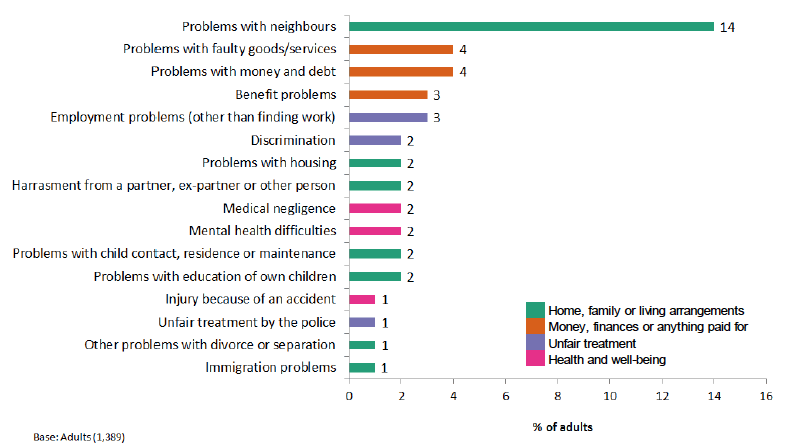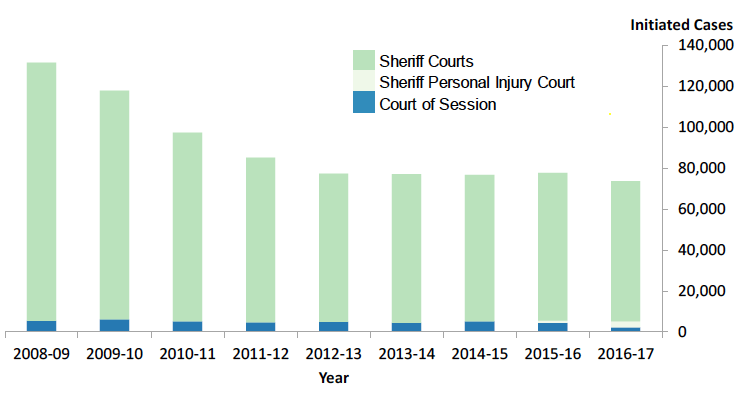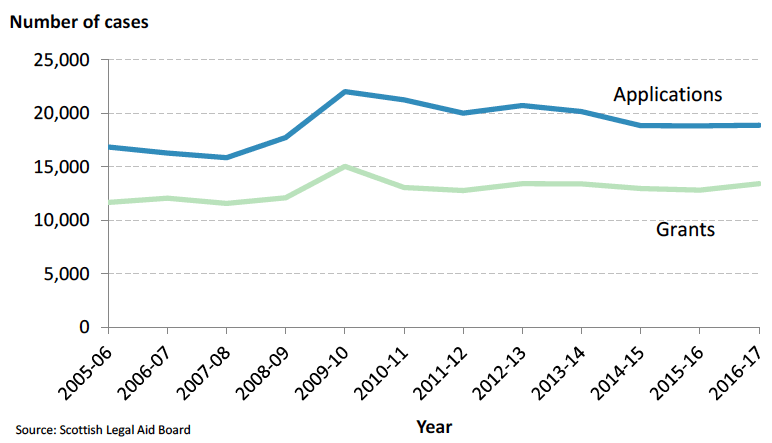Civil justice statistics in Scotland: 2016-2017
The 2016-17 Civil Justice in Scotland release includes main statistics tables and figures and supplementary statistics tables.
This document is part of a collection
4. Recent trends in civil justice
There were 73,640 civil law cases initiated in 2016-17, a small decrease from numbers recorded in the last four years
93% of civil law cases were raised in the sheriff courts (excluding Sheriff Personal Injury Court), and 33% of these were ordinary cause
Most civil legal aid grants were made for cases related to family issues
Data from the 2016-17 Scottish Crime and Justice Survey shows that civil law problems were estimated to have been experienced by around three in ten of the adult population during the previous three years
Scottish Crime and Justice Survey - civil justice module
The Scottish Crime and Justice Survey (SCJS)[5] includes questions on experience of and response to civil law problems. In 2016-17, respondents were asked if they had experienced any of a list of named problems or disputes in the three years prior to interview[6]. They were then asked whether they had attempted to solve them.
The problem areas covered were:
- home or family living arrangements
- money, finances or anything paid for
- unfair treatment
- health and well-being
The 2016-17 SCJS shows that around three in ten adults (29%) were estimated to have experienced at least one of the civil law problems asked about in the last three years. This is an increase from the 21% reported in 2014-15, but similar to the 30% reported in the 2008-09 SCJS[7].
Among the problem areas listed above, 19% of adults had experienced problems with home or family living arrangements, 10% had experienced problems with money, finances or anything they had paid for, 5% had been treated unfairly in some respect and 4% had experienced health or well-being problems.
The most common single problem was with neighbours, experienced by 14% of adults. The next most common civil law problems involved faulty goods or services (4%) or money & debt (4%). A more detailed breakdown is shown in Figure 4.
Figure 4: Experience of civil law problems: SCJS 2016-17

When we consider only those that had experienced one or more civil law problems in the last three years, over a third (36%) said a problem concerning neighbours was their most important or only problem to solve. The next most important problems involved faulty goods or services (10%) or money and debt (7%).
Thirty-one per cent of these problems began less than 12 months ago, a further 18% over a year but less than two years ago, 20% over two years but less than three years ago and 30% over three years ago.
Around half (47%) had resolved the problem, while just under a third (32%) were still trying to resolve the problem. One in ten had tried to resolve the problem but had to give up (10%) and 9% were not planning to do anything.
Some groups in the population were more likely to experience civil law problems than the general population. For example, an estimated 36% of those who are disabled experienced a civil law problem compared with 27% of those who are not disabled. Victims of crime are also most likely to experience any civil law problem (47%) compared with non-victims (26%).
Courts statistics - overview
There were 73,640 civil law cases initiated across the Court of Session, sheriff courts and Sheriff Personal Injury Court in 2016-17 (not including summary applications) (Table 1). This is a 5% drop from the previous year, and is 44% lower than in 2008-09. The number of cases initiated in 2016-17 was lower than the relatively stable trend in the last four years. This decrease continues the overall downward trend observed since 2008-09. Figure 5 shows a breakdown of these initiated cases.
Figure 5: Civil law cases initiated in Court of Session, sheriff courts and Sheriff Personal Injury Court

There were 66,895 disposals of civil law cases in 2016-17 (Table 1). This is 6% lower than the number of cases disposed of in 2015-16 and 42% lower than in 2008-09. The trends in initiations and disposals are similar.
The year-on-year change in case numbers was not consistent across courts, sheriffdoms or case types in 2016-17. The number of cases initiated in the sheriff courts decreased in line with the overall trend while the Court of Session saw a much steeper decrease due to more personal injuries cases moving to the Sheriff Personal Injury Court. The Court of Session decreased by 48% (Table 2), while for cases in the sheriff courts the decrease was 5% (Table 3). There was also variation within sheriffdoms, as all except Glasgow and Strathkelvin handled fewer cases, compared to the previous year (Table 4). The case type mix for initiations has also changed with an increase in family and damages cases, but a drop in personal injury, eviction, repossession and particularly debt cases (Table 27).
Debt makes up the largest category (42%) of civil law cases handled by the courts in Scotland (Table 11). Eviction (Table 22) and family (Table 5) make up the next largest categories followed by personal injury (Table 13), damages (Table 18) and repossession (Table 20).
Court of Session
There were 2,251 cases initiated in the Court of Session in 2016-17, a 48% decrease since 2015-16, and the lowest number of initiated cases since 2008-09. In 2016-17, 3,162 cases were disposed of (Table 2).
The Sheriff Personal Injury Court was established on 22 September 2015. On the same date, the minimum value of actions that can be raised in the Court of Session was raised from £5,000 to £100,000 (see Courts Reform section for more information). These measures were expected to change the distribution of personal injury cases so that the majority of personal injury cases that would have previously been raised in the Court of Session would instead be raised in the Sheriff Personal Injury Court (although personal injury cases may also continue to be raised in local sheriff courts). The statistics presented in this bulletin indeed show a 74% decrease in the number of personal injury cases initiated in the General Department of the Court of Session in 2016-17 compared to 2015-16 (Table 14, Civil Justice Statistics in Scotland 2015-16 Table 14), driving the aforementioned overall decrease in the number of cases initiated in the Court of Session. Personal injury cases still make up 54% of civil law cases initiated in the General Department in 2016-17 (Table 2, Table 14), down from 72% in 2015-16 (Table 2, Civil Justice Statistics in Scotland 2015-16 Table 14).
The Court of Session also deals with judicial review. This is a specialised type of court procedure that can be used to challenge the way a person or body with power or authority has made a decision. There were 343 judicial review cases initiated in 2016-17, a 31% drop since 2015-16. However, the peak in 2015-16 is explained in part due to a rise in number of judicial reviews ahead of the rules changing in September 2015. The rule changes are explained in the Courts Reform section. The recent drop follows increases in the previous four years (Table 24). Court actions for judicial review cover a range of different matters including planning permission and environmental cases. However, the majority of judicial review cases relate to immigration.
Sheriff courts
In 2016-17, there were 68,433 civil law cases initiated and 62,370 cases disposed of in the sheriff courts (Table 3). Both the number of cases initiated and disposed of decreased from last year, having remained relatively stable in the previous four years. Cases initiated have decreased by 46% since 2008-09, disposals have decreased by 44% in the same period.
All sheriffdoms in Scotland have seen a drop in the number of cases initiated and disposed of since 2008-09 (Table 4). Between 2015-16 and 2016-17, Lothian and Borders sheriffdom saw the largest decrease in initiated cases (12%), with Tayside, Central and Fife sheriffdom (9%) and North Strathclyde sheriffdom (6%) both recording fewer cases. The only sheriffdorm to record an increase in the number of initiated cases since 2015-16 was Glasgow and Strathkelvin (6%). South Strathclyde, Dumfries and Galloway sheriffdom recorded the highest number of sheriff court cases initiated in 2016-17 at 13,400 cases.
The National Records of Scotland mid-2016 population estimates were used to create population estimates for each sheriffdom (Supplementary Table S13). These estimates were then used to calculate the number of cases initiated and disposed of per 1,000 population. This allows direct comparison of the incidence of civil law cases in each sheriffdom. The overall number of cases initiated across Scotland was 13 for every 1,000 people in 2016-17 (Table 4). This rate is broadly similar across all sheriffdoms, with Glasgow and Strathkelvin having the highest rate (17 per 1,000).
There was a large variation in the number of civil law cases dealt with by individual sheriff courts in Scotland in 2016-17 (Supplementary Table S1). The number of cases handled by Glasgow Sheriff Court increased compared to the previous year and still had by far the largest number of cases initiated (12,514), followed by Edinburgh Sheriff Court (7,642). Courts in the more rural parts of Scotland dealt with far fewer cases, with Lochmaddy having the lowest number of cases initiated in 2016-17 (48 cases). A map showing the location of sheriff courts in Scotland is shown in Figure 14.
In addition to civil law cases concerned with disputes, sheriff courts also deal with commissary business, which relates to succession and access to a deceased person’s estate. In 2016-17, 22,586 ordinary estates were confirmed with an average value of £247,131 (Supplementary Table S6). There were also 1,947 small estates confirmed, with an average value of £22,767.
Sheriff Personal Injury Court
There were 2,956 personal injury cases initiated in the Sheriff Personal Injury Court in 2016-17 (Table 1). This is the first full financial year in which this court has been operational since its establishment on 22 September 2015. More information can be found in the Courts Reform section.
Civil legal aid
The Scottish Legal Aid Board (SLAB) administers legal aid, which is paid for out of public funds and helps towards the costs of legal advice and representation for those who qualify. It is designed to help individuals who would be unable to pay on their own to gain access to the legal system. In 2016-17, civil legal assistance made up around a third of the net total legal assistance expenditure in Scotland (the other two thirds being mostly criminal but also children’s legal assistance and grant funded programmes).
There are two main types of civil legal assistance: advice and assistance (including assistance by way of representation) and civil legal aid. Advice and assistance helps pay for advice from a solicitor on any matter of Scots law. Civil legal aid helps pay for a solicitor to take the case to court. Civil legal aid made up 16% of the number of grants of civil legal assistance. Civil legal aid cases cost more than other types of civil legal assistance, but they also produce large amounts of income. Therefore net expenditure on civil legal aid makes up slightly more than half of the total expenditure on civil legal assistance. Demand for and expenditure on civil legal aid has decreased in recent years. Figure 6 shows that demand (as measured by applications) peaked in 2009-10 following rises in the previous two years. Demand then fell overall until 2014-15 and has remained stable since then.
In 2016-17, there were 13,425 civil legal aid grants, the vast majority of which for cases in the sheriff courts. After steadily rising for over 10 years, legal aid grants in relation to intervention orders and guardianship orders under Part 6 of the Adults with Incapacity (Scotland) Act 2000 now represent the largest category of legal aid certificates issued, at 33% of all grants. The next largest category is contact/parentage, which accounted for 21% of all grants in 2016-17.
SLAB manages three grant funded programmes which include 102 different projects across Scotland to enable support for people affected by repossession, eviction, debt problems and benefits disputes. In 2016-17 these programmes enabled 28,595 new clients to access help, including representation at court or tribunal on 8,103 occasions.
Further information and data on legal aid is available from the Scottish Legal Aid Board Annual Report 2016-17.
Figure 6: Civil legal aid applications and grants

1. Applications and grants may not relate to the same cases because of the interval between an application and a decision to grant. Also note that granted cases may not always proceed.
Contact
There is a problem
Thanks for your feedback